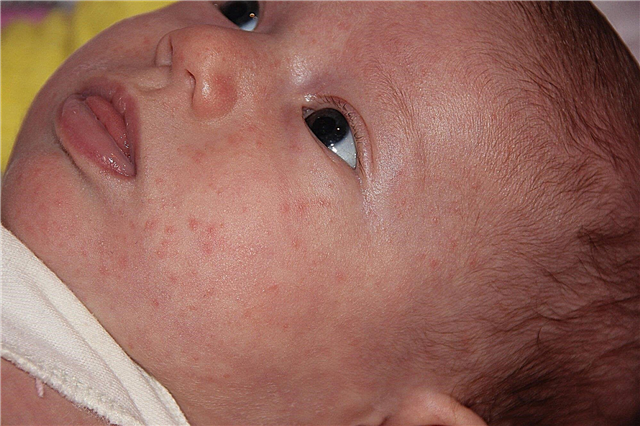Strabismus is the most common pathology of oculomotor functions. As statistics show, in Russia every year 5-7% of children with strabismus are born. In the next 3 years of life, pathology occurs in another 10% of babies. What is strabismus in a child: causes of development, types of disease, symptoms and prevention, what is imaginary strabismus, and how many months it passes, this article will tell.

Strabismus in a child is a pathology that occurs quite often
Causes of congenital strabismus in children
Strabismus (strabismus) is a violation of the motor functions of the eye, as a result of which they occupy the wrong position and cannot fully fulfill their main task - the visual one. In the normal position, the picture falls on the central areas of both eyes, after which the images are processed in the corresponding sections and combined into a single image. In the presence of pathology, such a fusion does not occur. To exclude double images, the central nervous system ceases to perceive the picture that the squinting eye receives.
Why does this condition occur? The reasons that can cause congenital squint are quite numerous:
- Significant visual impairment of any type (myopia, hyperopia, astigmatism);
- Neurological disorders - paralysis, paresis;
- CNS pathology;
- Abnormal attachment of the eye muscles;
- Injuries;
- Somatic diseases;
- Heredity;
- Oxygen starvation during gestation and childbirth;
- Cerebral palsy, Down syndrome and other congenital brain pathologies:
- Diseases of an infectious nature that the mother suffered at the beginning of pregnancy.
False and true squint
Feigned squint is most commonly seen in infants. The slanted-eye impression occurs due to the fact that the eyes are set close to the bridge of the nose, or the facial skull has a special structure. The most important reason is the immaturity of the central nervous system, which cannot sufficiently control the child's eye movements. A similar condition goes away on its own as the baby grows (usually, by six months, the eyes are completely aligned).
True strabismus is diagnosed at 5-6 months of age based on the results of a medical examination.

Imaginary squint
How to recognize strabismus in a newborn
You can determine an ailment in an infant by the following signs:
- The child's gaze is oblique, cannot focus on one point.
- There is no eye movement synchronization.
- The child turns the head to look at an object or object with one eye.
- The eyes do not react to bright light (normally the baby should turn away or close its eyes).
- Since the toddler cannot perceive the surrounding objects as volumetric, he constantly stumbles upon them, is poorly oriented in space.
- The child does not recognize mom, dad, other close people, does not distinguish between his own toys.
- The kid squints, trying to examine objects.
- The crumb does not track moving objects.
Important! All pathologies need to be identified and treated in a timely manner. Strabismus in newborns is no exception. It is necessary that parents be able to distinguish between the symptoms of the disease, and, if there are reasonable suspicions, they turn to a pediatric ophthalmologist. At the same time, in no case should one engage in self-medication, otherwise the situation will only worsen.
If it brings eyes to the bridge of the nose
Most of these cases are functional convergent strabismus. This condition is caused by the structural features of the baby's skull - due to the wide and low bridge of the nose, a significant part of the protein is not visible, which makes it seem as if the child is looking down. As it grows and develops, the bridge of the nose rises higher, pulls the skin behind it, and the signs of imaginary strabismus disappear by themselves.
If your eyes run in different directions
If a newborn's eyes are squinted in different directions, then this may be one of two types of strabismus:
- Functional. This is the name of the imaginary strabismus, which was discussed above. It is not a disease. This condition, in addition to the special structure of the skull, is also explained by the fact that the child, who was in the stage of intrauterine development, did not need to focus his gaze. For this reason, the eye muscles have not yet been trained by the time the baby is born. The areas of the brain that are responsible for the motor function of the eyes reach the desired level of development only by 3-4 months. Until then, eye movements are inconsistent.
- Persistent. With such a violation, the pupils cannot align on the same axis, therefore, they are directed in different directions. If this pathology is observed in a child from birth, then strabismus will not go away by 6 months.
If one eye squints
A condition in which one eye squints in a newborn child is dangerous by the development of amblyopia. It is a functional, reversible visual impairment in which one eye is not involved in visual activity. Since strabismus makes it impossible to combine the images that both eyes see into a single image, the brain "turns off" the function of one of the two eyes. It is not difficult to recognize such a violation: if the eye deviates (outward, downward, inward, upward), then the child has obvious health problems, and the baby should be shown to the ophthalmologist as soon as possible.
Important! Amblyopia occurs at a very young age and is most often the main cause of vision loss in babies.
Varieties of the described pathology
Today, more than 25 types of this pathology are known, in each individual case an individual approach to the problem is required. The types of strabismus differ according to several criteria:
- By the time of occurrence:
- Congenital;
- Acquired. It usually develops in children aged 3-5 years, suffering from visual impairment, in particular, hyperopia and astigmatism (in some cases it may be myopia).
- By eye involvement:
- One-sided. Otherwise, the pathology is called monolateral strabismus (in this case, one eye is squinted in the child). The disease is fraught with amblyopia;
- Intermittent (eyes squint alternately). Otherwise, it is called alternating (from the word "alternate" - to observe the sequence).
- By focus:
- Vertical (one eye is above or below the other);
- Converging (eyes are collected to the nose). Often combined with hyperopia;
- Divergent (eyes directed to the temples). Usually combined with myopia;
- Mixed (combination of converging or diverging strabismus with vertical).
- According to the stability of pathology:
- Permanent;
- Fickle.
- By origin:
- Paralytic. In this case, eye mobility is absent or limited;
- Friendly. It is characterized by the fact that one or both eyes squint alternately. At the same time, in different cases, the eyes can move in different directions.

Vertical squint
Strabismus is also distinguished:
- Imaginary;
- True.
In addition, the following types of diseases are noted:
- Accommodation. The violation is corrected by wearing the correct glasses;
- Partially accommodative. Does not disappear completely when wearing glasses.
- Non-accommodating. Glasses have no effect on pathology.
On a note. Accommodation is the ability of the eyes to focus on objects located at different distances from the viewer. The result is achieved by contracting and relaxing the corresponding muscles.
In addition to the listed varieties, there are the following:
- Strabismus with or without diplopia (double vision);
- With different angles (large, small, inconsistent);
- Esotropia (the eye goes inward).

Convergent squint
Examination by an ophthalmologist for children under one year old
The first medical examination is carried out almost immediately after childbirth. But a visit to an ophthalmologist is provided for only a few babies. An ophthalmologist's consultation can be prescribed by a neonatologist or a district pediatrician if the baby is at risk (examination is carried out in the maternity hospital or clinic, respectively).
The risk group includes:
- babies with a hereditary predisposition to eye diseases (for example, if the child's parents have pathologies of this kind);
- children born before the due date;
- babies born with complicated childbirth;
- children whose parents have bad habits.
The next examination is done at the age of 2 months, then at 6 months and a year. In these cases, all babies are checked without exception.
Before starting to treat strabismus in a child, it is necessary to make an accurate diagnosis based on a thorough examination. Further, appropriate treatment is prescribed, which includes a set of measures: conservative and, if required, surgical.
The category of conservative treatment of strabismus in infants includes methods that are aimed at improving vision. If the child has farsightedness or myopia, the doctor prescribes glasses. In addition, they help correct strabismus, but only if used in conjunction with other treatments. The purpose of the latter is to teach the kid to combine pictures perceived by the left and right eyes into a single image. This can be achieved through hardware treatment, which should be carried out 2-3 times a year, with one course lasting 2-3 weeks.
Important! Complex treatment of strabismus leads to recovery in 97% of cases.
What to do for parents
If a child's eye squints, or both eyes deviate to the side, the baby must be shown to a pediatric ophthalmologist. If the baby suffers from a congenital ailment, then the latter is diagnosed at 5-6 months.
If the diagnosis is confirmed, the visit to the ophthalmologist becomes regular. In the presence of severe hyperopia or myopia, the child is prescribed glasses.
On a note. By themselves, glasses will not correct squint, but will allow the child to see better. In addition, wearing glasses is an effective measure for preventing amblyopia: the brain will receive the correct image from the outside, so there will be no need to deprive the diseased eye of visual function.
If surgical intervention is required to solve the problem, then an MRI and ultrasound of the eyeball must be performed before the operation.
After the operation, a course of therapy is necessary to consolidate the positive result. Only in this case it is possible to cure strabismus completely and completely.

Examination for strabismus
How long does strabismus go in babies
The eyes of a newborn are often squinted almost immediately after birth. Many parents are interested in the question of when the eyes of newborns stop squinting. The well-known pediatrician E. Komarovsky claims that the cause and treatment (if required) should be established when the child reaches 4-6 months. In most cases, this phenomenon is temporary and goes away on its own by six months. For newborn babies, strabismus is a normal physiological condition.
Should I see a doctor
Earlier it was said when strabismus passes in newborns. If, after 6 months, the baby's eyes continue to squint, it is necessary to show the baby to an ophthalmologist in order to establish a diagnosis and begin adequate and timely treatment.
Possible complications
If the baby's eyes are squinting, then do not hesitate to visit the doctor. It is quite simple to eliminate a mild form of pathology. The advanced disease interferes with the formation of binocular vision. As a result, the body of the crumbs is forced to develop compensatory reflexes, which in the future will only complicate treatment. In addition, in the presence of strabismus, visual impairment is an inevitable process. Also, with the long-term existence of pathology, amblyopia develops.
Prevention of childhood strabismus
Among the main preventive measures that will help to avoid the development of strabismus are:
- regular and timely examination of the child by an ophthalmologist;
- protection of women's health during pregnancy;
- avoidance of stressful situations;
- timely treatment of diseases that can cause strabismus (measles, scarlet fever, diphtheria, etc.).
Strabismus is common in childhood. In many cases, this condition is the norm, but pathological disorders are no less common. That is why it is important to undergo regular check-ups with a pediatric ophthalmologist - it is better to insure yourself once again than to treat an advanced disease later. You cannot do home treatment.



